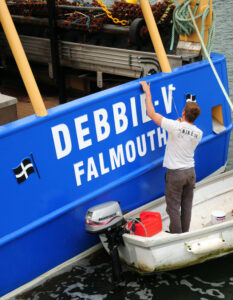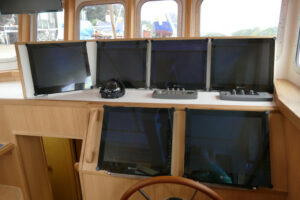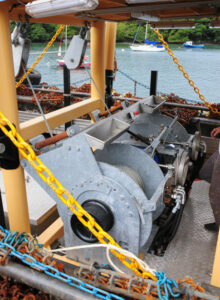A new steel scalloper has recently been completed by Chris Vinnicombe of the Amethyst Fishing Company and his team, who are based at Mylor Quay near Falmouth, reports Martin Johns

The 11.99m Debbie V is now scalloping off the south coast of Cornwall.
Named Debbie V after the owner’s wife, the boat was designed by renowned Cornish naval architect Denis Swire from Porthleven, and has an overall length of 11.99m, a substantial beam of 5.9m, and a draught of 3.4m.
The scalloper, to be skippered by Tom Beresford, sets a new benchmark in the region for the quality of her fit-out, which is nothing short of yacht standard.
Owner Chris Vinnicombe has always had the admirable policy of using local suppliers, contractors and tradesmen whenever possible, and this ethos shines through the entire construction of Debbie V FH 555, which is insured with Sunderland Marine.
The policy is reflected in the fact that the vast majority of the contractors and suppliers involved in the building of his new vessel are based in Cornwall or Devon, within around 60 miles of his Mylor base.
The completed hull and steel superstructure of the scalloper were built to float-away stage by Mashfords Boatyard at Cremyll in southeast Cornwall, before being completed at the owner’s base.
A 9m-long 300mm x 300mm steel ballast keel, weighing around 5t, was first laid, upon which the 50mm-thick keel and 10mm-thick frames, at 450mm centres, were assembled.

The starboard set of six dredges, hanging alongside the stainless steel catch conveyor.
Debbie V’s hull plating is 6mm steel, with 7mm plating across the transom and around the stern quarters to satisfy Seafish regulations for stern trawlers.
Hefty 30mm round chine bars run forward to a fully-formed bulbous bow, which creates substantial additional buoyancy, as well as having the effect of making the entire boat much fuller beneath the water from bow to stern.
The fully-formed bulbous bow uses rolled plates to incorporate compound curves, and was incorporated as an evolution to the original design, when further lower chine developments also took place.
The boat’s steel hull and 5mm-thick superstructure plating were supplied ready-cut to Mashfords in kit form by Dutch company Snytech and Thompsons of Middlesbrough.
Designer Jim Moore converted the boat’s drawings to CAD data to enable automated cutting of the steelwork.
Once completed, the hull and superstructure were launched and towed to Mylor Quay near Falmouth, where the rest of the fit-out then commenced.

Debbie V’s main engine is the popular Volvo Penta D13 MH.
Of forward wheelhouse design, the boat is rigged to tow either six or seven dredges aside from 6m-long 150mm-diameter derricks pivoted off a midships A-frame, constructed by Newlyn company JT Fabrications.
Welders Hazel Dunn, from Mashfords, and Tony Medlock were employed during the fit-out stage to help fabricate the stern gantry and other steelwork.
Between the wheelhouse and A-frame is fitted a super-heavy-duty Spencer Carter two-drum trawl winch, specifically designed to cope with the rigours of scalloping.
Custom-built for Debbie V, the trawl winch is described by skipper Tom Beresford as being ‘ample for the job’ and, like all the boat’s equipment, it will always be running well within capacity.
The main warps are led through overhead guide-on gear passing through hanging blocks on the A-frame, before going aft to two blocks across the gantry cross-beam and to the derrick ends. Tipping winch warps follow a similar route to the main warps, and their tension, when not in use, acts as an adjustable back-stay for the derricks.

Debbie V going into Newlyn.
Four Spencer Carter-supplied 3t Rotzler Gilson winches are fitted on the wheelhouse roof and handle topping and dredge-tipping duties, while two additional 2t Rotzler winches, fitted transversely either side of the fishroom hatch, are used to pull down the dredge bobbin bars onto secure cradles above the catch conveyors.
A carefully designed hydraulic system provides ample power for the winches and catch conveyors. Feeding from an 800-litre hydraulic oil tank, a 180cc Danfoss piston pump is driven directly off the fore end of the main engine crankshaft and provides power to the Spencer Carter trawl winch, while a gearbox-driven tandem pump powers the six Rotzler winches, with one circuit for the winches on either side of the boat.
A third hydraulic pump, with a separate oil tank, powers the two MW Engineering stainless steel catch conveyors, which run fore to aft, and discharge debris and rocks through large scuppers in the transom.
All Debbie V’s pipework is made from 316 stainless steel, with no mild steel pipe aboard the boat at all.
The extensive and extremely neat hydraulic pipework system was completed by Mike Curnow of Redruth-based Ocean Hydraulics.

Skipper Tom Beresford putting the finishing touches to the paintwork.
The new scalloper is powered by the extremely popular Volvo Penta D13 MH engine, coupled to a ZF 6:1 reduction gearbox. Both were supplied by local agents Marine Engineering (Looe) Ltd.
All stern gear aft of the gearbox has been supplied by C&O Engineering of Abbotskerswell, and includes a one-piece 5in-diameter shaft and a four-bladed Michigan propeller, turning within a 1,620mm-diameter x 850mm-long propulsion nozzle to provide additional thrust.
The hydraulic steering is a powered hydro-slave twin-ram system supplied by Spencer Carter, and is fed from a 200-litre oil tank and operated via a Vetus steering wheel.
Two 4,000-litre steel fuel tanks were fitted either side of the engineroom during the steelwork fabrication stage.
Freshwater tanks with a total capacity of 4,800 litres are fitted in each stern quarter, with the bulbous bow being a third water tank. Pumps fitted adjacent to each tank allow water to be redistributed between tanks, to retain the correct trim levels as fuel and water is used and the fishroom fills up.
Debbie V’s electrical power comes from a four-cylinder Kubota 30kVA three-phase generator, located on a shelf forward of the starboard fuel tank and supplied by Brixham company UCS. Additional 110V and 240V single-phase electricity is provided by a Victron 5kW inverter charger, while a shore power circuit is also fitted on the boat.

The tandem hydraulic pump on the fore end of the main engine.
All electrical work was completed by H&H Electrical of Gweek, by Ricky Rosevear and his team of marine electricians Ben, Jed, Woody and Josh.
Aft of the engineroom is a spacious GRP-lined fishroom, calculated to have a bulk capacity of 20t.
Polruan-based refrigeration specialist Alpino Refrigeration, run by Alex Pino, installed a custom-made fishroom cooling system.
The refrigeration system has been fitted to the owner and skipper’s exacting standards, and comprises 130m of 22mm-diameter 316 stainless steel tubing, fitted to the deckhead with stainless channel iron and high-density plastic clips.
Alpino’s latest high-tech electro-hydraulic pipe-bending machine enabled tight radius return bends to be made, meaning far fewer welded joints on the system and closer-spaced freezing pipework.

Six Neovo flat screens are flush-fitted in a wraparound console.
An additional 40m of 16mm-diameter tubing forms a cooling circuit on the forward bulkhead of the fishroom.
The refrigeration plant, fitted in the port shoulder of the engineroom, is one of Alpino’s standard units, which is now tried and tested on over 20 boats. This comprises a three-phase Bock semi-hermetic compressor, a three-phase Jabsco 1in flexible impeller pump, a Bitzer 7.3kW seawater-resistant shell and tube condenser, and a GKN six-litre liquid receiver.
Along with a bespoke control panel, this is all mounted on its own shelf, keeping the package neat and small. The three expansion valves are situated in the engineroom; again, this is to minimise the risk of corrosion in the hold, while the three valves provide redundancy – should a valve fail, the system will always have two-thirds of its cooling capacity available.
The entire system is controlled by a small digital controller in the wheelhouse, and maintains a constant temperature of between 0°C and 2°C.
Nowhere is the outstanding quality of the fit-out more apparent than in the wheelhouse, where oak-faced laminates, trimmed with solid oak edging, line the entire area.

Alpino fishroom refrigeration equipment installed in the engineroom.
A skipper’s seat to starboard is flanked by various base and overhead control consoles, bringing everything within easy reach, while wraparound consoles forward house the comprehensive electronics package.
A solid oak mess table with bench seating is fitted on the port side of the wheelhouse.
An extensive package of wheelhouse electronics has been supplied by SIRM UK’s Penryn branch, and comprises a twin-screen Olex system with hardness and softness module, JRC radar, JRC sounder, Furuno MaxSea plotter, JRC satellite compass, Navitron autopilot, Navitron rudder indicator, two Furuno GP32 GPS navigators, two Sailor DSC VHF radios, and a four-camera CCTV system.
All navigation equipment is of the hidden ‘black box’ type, and data is displayed on six 12V Neovo flat screens, incorporated into the wraparound forward console.
Other controls, such as hydraulic read-outs, generator controls, stop-button panel, and refrigeration controller, are fitted either overhead, above the front windows, or in an overhead console adjacent to the skipper’s seat.

Two-tonne Rotzler pull-down winches are fitted either side of the fishroom hatch.
A Volvo Penta fly-by-wire engine control is fitted starboard of the skipper’s seat, with a jog switch fitted to the port side.
All of the boat’s lights, with the exception of the navigation lights, are low-energy LED lights.
Forward of the wheelhouse is a spacious accommodation and galley area, accessed either through the wheelhouse or via a watertight GRP-lined area to starboard, where wet oilskins and boots can be stored.
Three bunk-style berths and a GRP toilet and wet room shower dominate the port side of the area, with a further transverse berth under the wheelhouse floor.
Starboard of the centreline is a galley comprising a ceramic hob, stainless steel oven, microwave, fridge, and associated kitchen units. The level of comfort in both the wheelhouse and the accommodation area is further enhanced by a combined heating and air conditioning system.
Commercial-grade oak-finish Karndean flooring is fitted throughout the wheelhouse and accommodation area.
All carpentry work in the forward areas was carried out by local joiner Kevin Jenkins, for whom Chris Vinnicombe has nothing but the utmost praise. Chris had employed Kevin to carry out similar work during a rebuild of a previous boat, and had no hesitation in using his services aboard Debbie V.

Spencer Carter-supplied custom-made blocks, with lugs for safety chains.
Aluminium-framed wheelhouse windows, featuring six openers, came from Essex company Technautic.
The scalloper’s deck is sheathed with 50mm-thick opepe hardwood, installed in single lengths onto welded studs, and caulked with teak deck sealant from Penryn company Seaware, which also supplied much of the hardware and fastenings for the new build. The beauty of the specialist deck caulking is that it can be sanded once it has cured, making a much neater job than the more usual uneven lines of pitch.
Debbie V has a full stability booklet, prepared by her designer Denis Swire, and was tested by him in a fully seagoing state. Although not required to carry a stability booklet as she is under 12m long, Chris Vinnicombe was keen to ensure she was fully tested, for his own peace of mind and that of his crew.
The scalloper performed well in sea trials off Falmouth, achieving a top speed of 10 knots at 1,800rpm from her 221kW main engine, with a cruising speed of eight knots at 1,450rpm. It was also noted during sea trials that Debbie V produced very little wake, which was attributed in the main to her full bulbous bow.
The boat has been found to be very manoeuvrable, and turns virtually within her own length, helped by her large rudder. No bow thruster is fitted, nor is one required, according to her owner and skipper.

Controls for all winches are fitted within very easy reach of the trawl winch operator.
As well as being fitted out by mostly local contractors, Debbie V also has a local crew. This is, in the main, made up of family members. Skipper Tom Beresford is Chris Vinnicombe’s son-in-law, while crewman Mikey Cartlidge is Tom’s brother.
The third crewman, Ryan Lane, is a local Mylor lad who, while working as a marine engineer for Pendennis Shipyard in nearby Falmouth, expressed an interest in becoming a fisherman to Chris Vinnicombe. At the time, around 12 months ago, Chris was rebuilding Rebecca V, so Ryan’s expertise was utilised in that project before he started similar work aboard Debbie V. Now, a year later, Ryan is at last realising his dream of becoming a fisherman.
Chris Vinnicombe’s youngest son, Pat, also helped with the fit-out.
The extremely high quality of Debbie V’s fit-out is immediately apparent throughout the vessel, and was driven by both Chris and Tom’s fantastic attention to detail, and the need for all aspects of the work to be carried out to their exacting standards – something that could not have been achieved by a commercial boatyard, due to time and cost constraints.
Debbie V’s hull and superstructure was shot-blasted by Longdowns company Blast Clean & Coatings, before being hot zinc-sprayed and epoxy-coated. This was followed by two coats of International French Blue two-pack paint – although in light of recent events in the Baie de Seine, the crew has now renamed the shade Amethyst Blue.
The boat’s hull is protected against damage by the dredges by 15mm-thick rubber belting.

The framework of Debbie V under build at Mashfords Boatyard, Cremyll.
The scalloper’s chandlery was supplied by MarineCo of Saltash and Gael Force, with her 20mm-diameter and 150 fathom-long warps being supplied by Karl Thomson of Buckie. The scallop dredges are a combination of Deeside frames, Jon Reid bellies, and bobbin bars manufactured in-house by the Amethyst Fishing team.
Custom-made heavy-duty Spencer Carter blocks, incorporating lugs for safety chains, are fitted.
Debbie V has joined another Denis Swire-designed steel scalloper in Chris Vinnicombe’s fleet – the 11.4m Lily Grace FH 444, which was built as Girl Debra E 444 by AJ Marine at Padstow in 1989.
Lily Grace was extensively refitted and re-engined six years ago by Chris Vinnicombe and his team at Mylor Quay. She has subsequently been operating so successfully under skipper Tom Beresford that her layout and much of her equipment has been used as the blueprint for the new scalloper.
In a consolidation of Amethyst Fishing’s fleet of scallopers, two under-10m boats, Amethyst FH 664, also designed by Denis Swire, and the Dragon Marine-built Rebecca V FH 665, have both been sold to new owners in the South West.
Amethyst has been sold to skipper Joel Dunn and Darren Rosson of Plymouth, replacing their under-10m Capella PW 8 (sold to northeast Scotland and renamed Defiant PD 378), while Rebecca V has stayed in Cornwall under skipper/owner Dave Cowan of Polperro, replacing Cazadora FY 614.
Debbie V FH 555 was recently named in the customary fashion, with a bottle of champagne being broken against her rail by Chris Vinnicombe’s wife Debbie, at a naming ceremony attended by many family and friends of the owners (Fishing News, 20 September).
Debbie V has now started fishing, initially working locally on shakedown trips before she moves further afield, once the inevitable teething troubles are ironed out.
The boat is landing her catches to local processor Falfish, which made a donation of £150 to the Fishermen’s Mission for the first bag of scallops landed from Debbie V’s maiden trip in Falmouth Bay.








